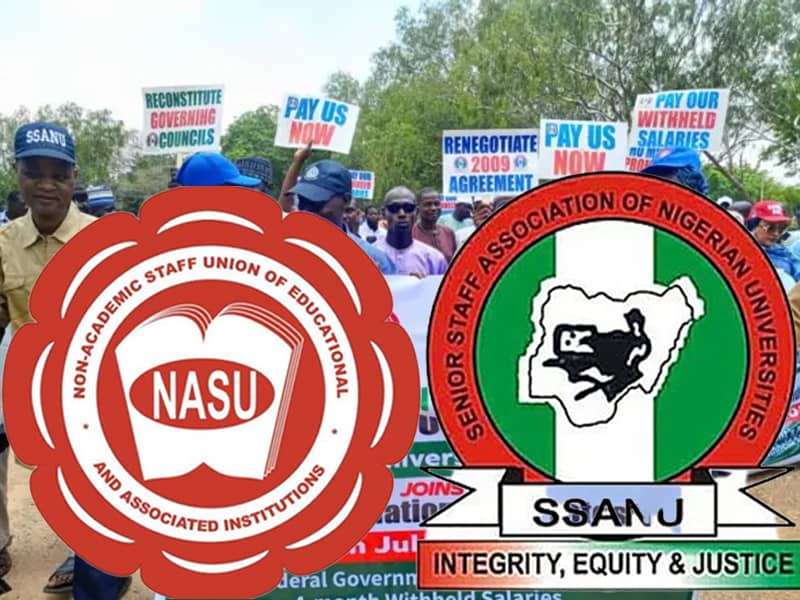
By: Ogunleye Kolapo Olayemi
Earlier last week, the Non-Academic Staff Union of Educational and Associated Institutions (NASU) and the Senior Staff Association of Nigerian Universities (SSANU) renewed their threat to embark on strike over unresolved disputes with the federal government. While the headlines capture a possible shutdown, the roots of this crisis run much deeper. This explainer takes a closer look at how a 2009 agreement, broken promises, and years of strained negotiations brought the university system to this point.
The Genesis
The crisis between the federal government and the non-academic unions in universities did not begin today. Its roots stretch back to the 2009 FGN–SSANU–NASU Agreement, a landmark deal that was expected to end recurring disputes in the Nigerian university system. One of the major highlights of that agreement was the introduction of a new salary structure known as the Consolidated Tertiary Institutions Salary Structure (CONTISS). It was designed to improve the pay and welfare of non-academic staff. The deal also contained several allowances meant to compensate workers for risks, responsibilities, and extra duties. For instance, hazard allowance was meant for staff working in high-risk environments such as laboratories, workshops, or clinics. Responsibility allowance was attached to leadership positions like registrars, bursars, and heads of departments. Other provisions covered staff who worked beyond normal hours, those who took on excess workload, and those who went on field trips or engaged in research supervision. There were also allowances for rural postings, journal duties, and annual leave. In addition, the agreement extended sabbatical leave to senior non-teaching staff, a privilege that had mostly been reserved for academics before then.
Broken Promises
The problem has been in implementation. Over the years, successive governments have either ignored or partially fulfilled the 2009 agreement, leading to repeated strikes and failed negotiations. One major sticking point is what the unions call “earned allowances”—the arrears and special allowances captured in the 2009 deal. They have consistently accused the government of unfair and skewed disbursement formulas. This issue alone has triggered several strikes, notably in 2017, 2021, and 2022. The matter of withheld salaries has also deepened the conflict. In 2022, non-academic staff embarked on a four-month strike over the government’s failure to meet their demands. The Buhari administration responded with a strict “No Work, No Pay” policy, leaving their salaries unpaid for that period. When President Bola Tinubu later approved the payment of four months’ withheld salaries for ASUU but kept silent on NASU and SSANU, the move was seen as selective treatment and further fueled resentment. The non-payment of these withheld salaries remains one of their strongest demands today.
Union Demands
At present, NASU and SSANU are insisting on the immediate payment of two months’ withheld salaries, alongside arrears from the 25 and 35 percent salary increments. They also want what they consider a fairer share of the ₦50 billion earned allowances fund, arguing that the government and the National Universities Commission (NUC) distributed it unjustly and even excluded some categories of staff entirely. Another critical demand is the full renegotiation of the 2009 agreement. The unions accuse the government of dragging its feet on this process while seemingly giving quicker attention to renegotiations with ASUU.
Government Response
In response to the growing agitation, the Minister of State for Education, Dr. Tunji Alausa, held a meeting with union leaders. That engagement produced a Tripartite Committee made up of representatives from the Ministry of Education, the NUC, and the unions. However, SSANU and NASU maintain that the committee has failed to make tangible progress on their concerns, leaving most of the issues unresolved.Potential Impact of a StrikeIf the unions decide to go ahead with a total and indefinite strike, the consequences for the university system would be dire. Non-academic staff, who include technicians, administrators, cleaners, porters, and security personnel, are the backbone of campus life. Without them, administrative, financial, and logistical operations would likely grind to a halt.
Such a strike could disrupt the academic calendar, force prolonged closures, and create uncertainty for students. The unions have already warned that their next move might be the “grandfather of all strikes.” The question now is whether the federal government will meet their demands to avert a shutdown. Only time will tell.
